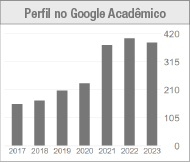Thoughts about Time-Rhythm and the transition between Spoken and Sung Word in Musical Theatre
DOI:
https://doi.org/10.5965/1414573102512024e0208Keywords:
Time-Rhythm, Musical Theatre, transition, spoken Word, sung WordAbstract
This work proposes thoughts about the concept of Time-Rhythm and some of its possibilities in Musical Theatre, especially with regard to the transition between Spoken and Sung Words. We present a contextualization of this concept, first raising definitions of Time and Rhythm separately, since their definitions used in Music and Theatre, going through Stanislavski and the development of the Time-Rhythm concept itself, up to the dialogue with other researchers on the subject, such as Jerzy Grotowski, Renato Ferracini and Jacyan Castilho. Finally, we present possibilities for the relationship between Time-Rhythmand the transition between Spoken and Sung Words in Musical Theatre shows.
Downloads
References
BIÃO, Armindo Jorge de Carvalho. A Presença do Corpo em Cena nos Estudos da Performance e na Etnocenologia. Revista Brasileira de Estudos da Presença, Porto Alegre, 2011, v. 1, n. 2,p. 346-359. Disponível em: https://doi.org/10.1590/2237-266022804. Acesso em: 8 mar. 2022.
BOHUMIL, Med. Teoria da música. 4. ed. rev. e ampl. Brasília: Musimed, 1996.
CASTILHO, Jacyan. Ritmo e dinâmica no espetáculo teatral. São Paulo: Perspectiva, 2013.
CHEKHOV, Michael. Para o ator. São Paulo: Martins Fontes, 4ª Edição. 2003
DICIONÁRIO GROVE DE MÚSICA: EDIÇÃO CONCISA. Zahar; 1ª edição (1 dezembro 1994).
FERRACINI, Renato. Ensaios de atuação. São Paulo: Perspectiva, 2013.
FLASZEN, Ludwik; BARBA, Eugênio; POLLASTRELLI, Carla; MOLINARI, Renata. O Teatro Laboratório de Jerzy Grotowski 1959-1969. São Paulo: Perspectiva: SESC SP; Pontedera, IT: Fondazione Pontedera Teatro, 2007.
GRANDO, Mônica Andréa. O gesto vocal: a comunicação vocal e a sua gestualidade no teatro físico. São Paulo: Perspectiva: Teatro Macunaíma, 2015.
KUSNET, Eugênio. Ator e método. Rio de Janeiro: Instituto Nacional de Artes Cênicas, 1985.
LIGNELLI, César. Sonoplastia e/ou entorno acústico: seu lugar na cena teatral. 2008. Disponível em: https://www.publionline.iar.unicamp.br/index.php/abrace/issue/view/75 .
LIGNELLI, César. Sons & cenas: apreensão e produção de sentido a partir da dimensão acústica. 2011.Tese (Doutorado em Educação) - Universidade de Brasília, Brasília, 2011.
MUNDIM, Tiago Elias. Broadway ou West End: influências dos musicais anglófonos na produção dos musicais no (e do) Brasil. Urdimento - Revista de Estudos em Artes Cênicas. Dossiê Temático: O Teatro Popular Musical e suas multiplicidades. Florianópolis, v.2, n. 41, pp. 1-31, 2021. Disponível em: https://www.revistas.udesc.br/index.php/urdimento/article/view/20441.
MUNDIM, Tiago Elias. Contextualização do teatro musical na contemporaneidade: conceitos, treinamento do ator e inteligências múltiplas. 2014. 207 f., il. Dissertação (Mestrado em Artes) - Universidade de Brasília, Brasília, 2014.
MACIEL, A. da S. O tempo-ritmo em Grotowski e Stanislávski: possíveis contribuições para o treinamento do ator. 2016. Dissertação (Mestrado em Artes Cênicas) – Universidade Federal de Ouro Preto, Ouro Preto, 2016.
MOISÉS, Massaud. A criação literária: prosa I. São Paulo: Cultrix, 1993.
PAVIS, Patrice. Dicionário de Teatro. São Paulo: Perspectiva, 1998.
RICHARDS, Thomas. Trabalhar com Grotowski sobre as Ações Físicas. São Paulo: Perspectiva, 2012.
SANTOLIN, R. F. Constantin Stanislavski e o estúdio de ópera do Teatro Bolshoi: percursos e pensamentos sobre ópera. DAPesquisa, Florianópolis, v. 7, n. 9, p. 037-050, 2018. DOI: 10.5965/1808312907092012037.
SCHAFER, R. Murray. O ouvido pensante. São Paulo: Fundação Editora da UNESP, 1991.
STANISLÁVSKI, Konstantin. O trabalho do ator: diário de um aluno. Trad. Vitória Costa. São Paulo: Martins Fontes, 2017.
STANISLAVSKI, Constantin. Construção da Personagem. Trad. Pontes de Paula Lima. Rio de Janeiro: Civilização Brasileira. 1970.
STANISLAVSKI, Constantin. Minha Vida na Arte. Trad. Paulo Bezerra. Rio de Janeiro: Civilização Brasileira. 1989.
VENEZIANO, Neyde. Melodrama e Tecnologia no Musical Brasileiro. Anais do Congresso da ABRACE , Belo Horizonte, 2008.
Published
How to Cite
Issue
Section
License
Copyright (c) 2024 Urdimento: Revista de Estudos em Artes Cênicas

This work is licensed under a Creative Commons Attribution 4.0 International License.
Copyright Statement
The articles published by the magazine are free to use. The copyright is all assigned to the magazine. The articles whose authors are identified represent the expression from the point of view of their authors and not the official position of the journal Urdimento. The author (s) undertakes whenever publishing material relating to the article published in Revista Urdimento mention the said publication as follows: This article was originally published by Urdimento magazine in its volume (put the volume), number (put the number) in the year of (put the year) and can be accessed at:
http://www.revistas.udesc.br/index.php/urdimento
This work is licensed under a Creative Commons Attribution 4.0 International License.




